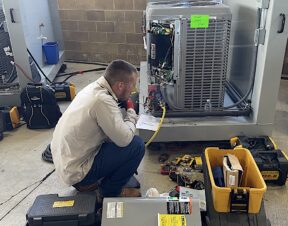Mechanical Hub presents this multi-part series on pressing technology. Every week MH will feature a Q&A with the leaders in pressing technology. Press technology is gaining momentum as the preferred choice in pipe joining. Introduced into the North American market in 1999 by Viega, pressing is gaining acceptance as the most efficient and cost effective method of joining piping materials. Press currently makes up nearly 12% of the copper fitting market, and that number is expected to rise with contractor education and training.
Mechanical Hub recently talked with some of the major players in the press technology market to learn more about what they are doing in this growing market.
Part 4 of the series continues with an exclusive interview with Dan Lucy, National Sales Manager at ROTHENBERGER USA.
 MH: Name some of the applications in which pressing is ideal?
MH: Name some of the applications in which pressing is ideal?
DL: There are two primary areas where Press really shines. The first is with smaller fittings in maintenance type applications. The ability to make a press fitting repair while the pipe is wet and without having to drain down a system means that hot water heater installations and repairs, tankless heater installations, and any type of building maintenance repair becomes much easier and more time efficient for both the repair/install technician and the building occupants/home owner. This also applies to installed piping systems below floors, behind walls, etc. where the ability to use a torch and sweat a fitting is limited.
The second application is the larger mechanical jobs where a contractor can justify the ease of installation and labor costs savings to offset the costs of the tools and the increased cost of the fittings.
MH: What is the scope of press piping? Copper, PEX, Stainless, Iron, etc.?
DL: The scope of press fittings is a better question for the fitting manufacturers. Currently there are copper, pex, stainless, and cast iron fittings but it will be the fitting manufacturers who take the market in different directions. As tool makers, both Rothenberger and Klauke work with the fitting manufacturers to try and understand where the market is going and to make sure the tools have the capacity to press the fittings being introduced.
MH: Are your pressing tools proprietary? Or can they be interchangeable with other manufacturer's pressing clamps and fittings?
DL: The press tool industry is a mixture of proprietary and common use jaws and tools. Again, the fitting manufacturer is very involved in that process with the ultimate authority to decide whether a new technology will go to market as a proprietary system or with the ability to meld into existing press tool technology.
MH: I have heard the pressing is used predominantly in Europe. Why has it taken the North American market so long to catch on?
CE: The U.S. market is not as quick to adopt new technologies or trends as the Europeans. We have seen the adoption of press technology grow in the U.S.; however, there is still a large contingency of end users that still prefer more familiar methods. (Chera Ellis, vice president and general manager at ROTHENBERGER contributed to this answer)
MH: Is pressing technology continually evolving? (effectiveness, ergonomics, weight, cordless & battery efficiency, larger pipe diameters, etc.)
DL: As with any new technology, the press guns have continued to evolve just like the fittings. Newer battery technologies, higher content of lighter metals and improved plastic moldings, more robust electro/mechanical systems in the guns, etc. have allowed the tool manufacturers to continue to provide improved products to the marketplace.
MH: I have used the pressing tools so the obvious question would be, why wouldn't contractors use pressing technology?
DL: Since you have used the guns and seen the response to the tools at our shows, I would say one of the biggest deterrents, especially in the current economy, is cost. A smaller plumber/mechanical can think of all the ways a press tool can improve his service response time but when he starts to do the math of the cost of a tool and the increased costs of the fittings the ease and relatively low cost of sweating a fitting comes into play. Hopefully as the economy continues to improve we’ll see that change. Also, as more and more piping systems become press friendly (copper, pex, stainless, etc) the tool’s flexibility to service all of those systems will increase its acceptance.
Dan Lucy, is the National Sales Manager at ROTHENBERGER USA.
Click on the product image for more information.




Join the conversation: